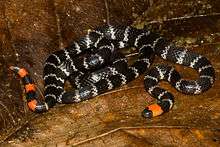Micrurus mipartitus
Micrurus mipartitus (redtail coral snake) is a species of coral snake in the family Elapidae.[1] It is found in South America and Central America. The redtail coral snake is common in agricultural areas in Colombia.[2] Its highly neurotoxic venom is known to cause seizures in its prey by activating nerve proteins responsible for seizures within it.[3]
| Micrurus mipartitus | |
|---|---|
 | |
| Scientific classification | |
| Kingdom: | Animalia |
| Phylum: | Chordata |
| Class: | Reptilia |
| Order: | Squamata |
| Suborder: | Serpentes |
| Family: | Elapidae |
| Genus: | Micrurus |
| Species: | M. mipartitus |
| Binomial name | |
| Micrurus mipartitus | |
Subspecies
- M. m. mipartitus (Duméril, Bibron, Duméril 1854).
- M. m. anomalus (Boulenger 1896).
- M. m. decussatus (Duméril, Bibron, Duméril 1854).
- M. m. popayanensis (Ayerbe, Tidwell, Tidwell 1990).
- M. m. rozei (Golay, Chiszar, Smith, Breukelen 1999).[4]
Phenotypic features
Micrurus mipartitus has a cylindrical body that can reach up to 140.6 centimeters in length[5]. They have quite small eyes upon their round heads. The rings of this species can range anywhere from 34-84 black bodily rings that are sundered by yellow or white intermediaries. The second ring on the head and 3 or 4 of the tail rings exude a red color in contrast to the white or yellow bands.[2]
Natural history
Micrurus mipartitus is a species of crepuscular and nocturnal habits. During period of low rainfall, could be located underground several centimeters deep. In times of high rainfall it's found on soil surface or where leaf litter is abundant. This coral snake lives from tropical dry forest to foggy forests and is related to human settlements in rural areas used for agriculture.[4]
The diet of M. mipartitus is mainly based on snakes (e.g. Atractus werneri, A. sanctamartae, Leptotyphlops spp.) as well as lizards (e.g. Lepidoblepharis sanctamartae), anphisbaenids (e.g. Amphisbaena spp.), anuros and cecilias (e.g. Caecilia gunteri). It's oviparous, about eight white-colored eggs have been recorded, which are 2.86 cm long, with an average weight of 3.06 gr. Incubation period lasts between 73–87 days, total length of the infants could vary from 20–21.9 cm and weight is around 3.3 gr.[4]
References
- Micrurus mipartitus at the Reptarium.cz Reptile Database. Accessed 20 December 2016.
- Cañas, Carlos A.; Castro-Herrera, Fernando; Castaño-Valencia, Santiago (14 February 2017). "Envenomation by the red-tailed coral snake (Micrurus mipartitus) in Colombia". Journal of Venomous Animals and Toxins including Tropical Diseases. 23 (1). doi:10.1186/s40409-017-0100-4. PMC 5307858. PMID 28228775. Retrieved 19 July 2018.
- "Red Tail Coral Snake Venom Activates Nerve Cell Proteins That Cause Seizures". www.reptilesmagazine.com. Retrieved 19 July 2018.
- "(PDF) Micrurus mipartitus (Duméril, Bibron y Duméril, 1854)". ResearchGate. Retrieved 2019-09-22.
- Vera-Pérez L E; Zúñiga-Baos J A; Ayerbe S. 2019. NUEVOS REGISTROS DE LONGITUD Y DIETA DE Micrurus mipartitus (DUMÉRIL, BIBRON Y DUMÉRIL, 1854) (SERPENTES: ELAPIDAE) Revista Novedades Colombianas. 14 (